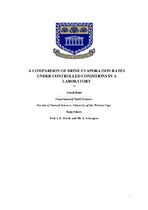| dc.contributor.advisor | Petrik, Leslie | |
| dc.contributor.author | Bent, Denzil | |
| dc.date.accessioned | 2018-10-03T10:36:30Z | |
| dc.date.available | 2018-12-31T22:10:06Z | |
| dc.date.issued | 2018 | |
| dc.identifier.uri | http://hdl.handle.net/11394/6443 | |
| dc.description | Magister Scientiae - MSc (Environ & Water Science) | |
| dc.description.abstract | There are growing concerns around the environmental issues related to processed water as the
demand for potable water is on the increase in South Africa. Effluents discharged from
various sectors such as water treatment facilities pose a constant threat to the environment
and natural water resources, including rivers and groundwater due to their poor chemical and
physical composition. As a result, the demand for predicting the elevated concentrations of
salts in a spatial and temporal dimension is constantly growing. The effluent at the
eMalahleni water reclamation plant in Mpumalanga, South Africa, is being processed through
a triple reverse osmosis that improves the water quality of the mine water to potable
standards. Two water quality streams emerge from this process, i.e. a potable standard and
the other a brine concentrate which is stored in ponds. Brine ponds are used for inland brine
disposal in the eMalahleni water reclamation plant. The large volumes and limited capacity to
store brines has placed great emphasis on enhanced evaporation rates to increase the
efficiency of the ponds. In order to improve the rate of brine evaporation in the pond, an
understanding of the effect of brine salt content and other parameters affecting the rate of
evaporation is required. This study aimed at establishing the physical and chemical behaviour
of the brine from the eMalahleni plant in a controlled environment. The investigation
incorporated actual brine from the eMalahleni plant as well as synthetic salts typical of the
major components of the eMalahleni brine. | |
| dc.language.iso | en | |
| dc.publisher | University of the Western Cape | |
| dc.subject | Acid mine drainage, Activity coefficient, Boundary layer, Environmental, Infrared radiation, Ions, pH, Precipitation, Salinity, Solubility, Vapour pressure, Water quality | |
| dc.title | A comparison of Brine evaporation rates under controlled conditions in a laboratory | |
| dc.rights.holder | University of the Western Cape | |

